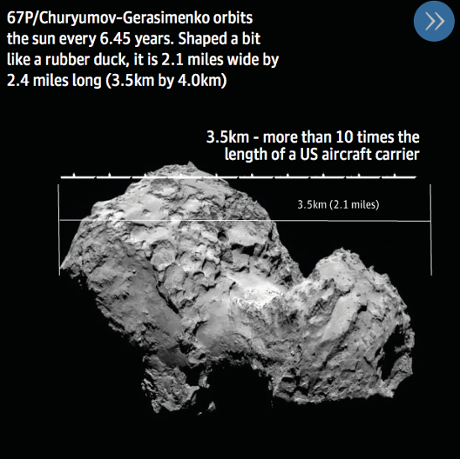登录彗星_探测生命起源
[摘要]对67P彗星进行探索研究将有望揭示有关太阳系起源和地球生命孕育更多的线索。

登陆器菲莱上的成像系统在彗星上空3公里处拍的照片
腾讯科技讯 11月13日,在菲莱(Philae)登陆器脱离欧洲航天局无人太空探测器“罗塞塔号”(Rosetta),向其指定目的地67P/Churyumov-Gerasimenko彗星飞去的途中,该项目的首席科学家赫尔曼·博汉德(Hermann Boehnhardt)说道:“我们感到越来越激动,也越来越紧张。”
格林威治时间周三16点(北京时间周四0点)过后不久,在经历了60多亿千米的漫长旅程以后,菲莱登陆器终于在67P彗星表面成功着陆,这颗彗星正在以最高1.35万千米的时速环绕太阳公转。
罗塞塔号此次飞行的负责人安德烈·埃克马索(Andrea Accomazzo)说道:“此刻我们感到无与伦比的开心。”
在过去20年时间里,博汉德和埃克马等负责该项目的科学家和工程师一直都在从事这个项目的相关工作,他们对菲莱登陆器能成功登陆感到激动自是理所应当。但对于从未接触过这个项目的普通人来说,罗塞塔号所肩负的太空探测任务到底有哪些激动人心之处呢?
1. 这是人类发射的航天器首次在一颗彗星的表面登陆。
这次成功登陆标志着,人类发射的航天器首次在一颗高速运行中的彗星表面着陆。在太空探索的历史上,这代表着一个重大的里程碑。
由于彗星是太阳系形成过程中留下的残留天体,因此对67P彗星进行探索研究将有望揭示有关太阳系起源和地球生命孕育的进一步线索。

2. 罗塞塔号将告诉世人,彗星是不是让地球变成蓝色的根源所在。
罗塞塔号将告诉世人,地球上的海洋是不是亿万年前彗星撞击所带来的结果,以及彗星撞击是否带来了所有生命的基础材料。
彗星是太阳系内部行星形成过程中留下的冰质残留天体。通过测量,人类已经得知彗星的大部分组成材料都是水冰。水冰在被太阳热能加热后会变成蒸汽,从而产生仅用显微镜可见的尘粒。在67P彗星接近近日轨道时,这颗彗星将会升温,某些尘粒将会因此脱落。对科学家来说,罗塞塔号所将带回来的尘粒将会揭示67P彗星的地质学情况。
这种测量将有助于科学家回答一个问题:是不是亿万年前的彗星撞击给地球带来了水和简单的有机分子,从而为生命的形成铺平了道路。

3. 67P彗星内部含有太阳系在45亿年以前形成时的成分。
罗塞塔号已经创造了历史,这艘无人太空探测器在环绕目标彗星运转的过程中收集了截至目前为止有关其内核成分、围绕内核的气状物成分以及内核表面地图的最为详尽的信息。
67P彗星内部含有太阳系在45亿年前形成时的原始成分,对其进行研究分析所得出的结果有助于科学家改进太阳系模型,更好地认识一颗行星是如何变得适合生命繁衍的。
4. 一种关键性的登陆仪器在降落过程中失灵。
67P彗星表面的重力十分微弱,以至于如果一名宇航员站在这颗彗星的表面上,那么只需轻轻一跳就能摆脱其万有引力的束缚。在登陆这颗彗星时,菲莱登陆器使用了两个鱼叉及其三条长“腿”上的螺旋冰锥。
菲莱登陆器配备的鱼叉只可使用一次,不能缩回并重新发射。而在登陆前非常严重的一个问题是,菲莱的一个推进器已在周二失灵。这个推进器原本设计为在登陆时发射,防止菲莱在发射鱼叉时从67P彗星表面弹出。
该项目的研究人员、澳大利亚斯威本科技大学(Swinburne University)的天文学家阿伦·达菲(Alan Duffy)博士说道:“没有推进器就意味着,如果登陆器在着陆时形成的碎冰和岩石被压在下面,那么登陆器就无法改变路线。”

5. 菲莱登陆器需在一平方千米的着陆区域内登陆。
67P彗星的大小相当于勃朗峰(阿尔卑斯山脉的最高峰),形状则类似于一个不规则的橡皮鸭,表面布满悬崖和斜坡,还有大大小小的坑洞和巨石。在科学家在7月份发现这颗彗星的形状时,有些人曾认为登陆将是一项不可能的任务。
在排除了几个过于危险的登陆地点以后,项目人员最终选定了一个方圆一千米的区域作为着陆点,并将其命名为“Agilkia”。
如果菲莱登陆器未能在这个着陆区域内登陆,那么就很有可能会翻倒。为了在正确区域着陆,任务控制人员必须将彗星表面的粉尘和水蒸气及其不规则形状的重力场等因素都考虑在内。
6. 菲莱登陆器的成功几率不足75%。
在登陆以前,任务负责人弗雷德·詹森(Fred Jansen)认为成功着陆的几率为75%。鉴于欧洲航天局对该项目投入了10亿欧元(约合16亿美元)的资金,而且罗塞塔号在长达十年的时间里渡过了60亿千米的旅程才最终抵达67P彗星,这个比例实在算不上高。
而在周二,当菲莱登陆器上的推进器失灵以后,这个比例更是进一步下降。詹森说道:“20年前我们说想要在一颗彗星上着陆时,我们对这颗彗星一无所知,因此风险是必然存在的。”
“这项任务已经成为了太空探索历史上的重大成就。”菲莱登陆器的负责人斯特凡·尤拉米克(Stephan Ulamec),他在过去18年时间里一直都在从事这个项目。“探索本来就意味着风险。如果没有做好承担风险的准备,那么就不该探索。”(瑞雪)
网址
http://rt.com/news/205099-rosetta-philae-comet-aliens/
The Rosetta mission’s historic landing of a robotic spacecraft on a comet has brought to a head one of humankind’s timeless questions: are we alone in the universe? For the project’s leading land scientist, that answer may soon be on the horizon.
After a tense seven-hour wait, the lander module Philae touched down on the surface of Comet 67P/Churyumov–Gerasimenko at 16:03 GMT on Wednesday. The European Space Agency’s (ESA) mission control in Darmstadt was beside itself with joy. The impossible had become reality. And it was only the beginning.
READ MORE: First #CometLanding in history as Rosetta‘s Philae touches down
Soon, the first descent image came in, the clarity of the comet surface seemingly from a Hollywood blockbuster. Despite that amazing feat, what follows could revolutionize our understanding of life itself.

With 64 hours of battery power, Philae has a limited window to surf the comet, study its surface, and find out what happens as it approaches the sun.
But for Jean-Pierre Bibring, the astrophysicist who has worked on the Rosetta mission for over two decades, the crucial question of our very existence could be found on that relatively tiny spot in the solar system.
“When you observe the solar system now, actually we do not understand why life started here. We are convinced that really the keys were in the origin of the system itself; the process that‘s really governed the modeling of different pass-ways,” Bibring said on Wednesday.
“We are essentially convinced that these molecules, with their specific composition and structures, when they were fed in the oceans of the earth and possibly of other planets, were the missing link to the emergence of life,” he continued.
Bibring extols the “beauty” of the comet, saying it has the ability to preserve the composition of the ingredients out of which the entire solar system formed.
“In particular, we know that comets are made out of ice, so they should be very bright, [but] they are darker than that. Why? Because most of the carbon is in the form of complex molecules that were formed prior to planets themselves forming, probably with a high level of complexity,” Bibring said.
His comments touch on the theory of panspermia, which posits that life exists throughout the universe and is spread by asteroids comets and other astronomical objects. The theory, in fact, is nothing new. The Greek philosopher Anaxagoras first mentioned the term panspermia (pan means “all”, spermia means “seeds”) in the 5th century BC.
The theory, however, did not become a topic of deeper scientific inquiry until the 1800s.
Philae is in a unique position to gather evidence for that hypothesis, as it is set to explore whether amino acids – the building blocks of life – exist on the comets surface.
Shrouded in ice, comets are viewed as fossils from our solar system’s formation. Those traveling from the distant Oort cloud – a spherical cloud of predominantly icy objects believed to surround the Sun – are of particular interest. Lying ‘untouched’ by the sun, they offer a rare glimpse into our inner solar system, along with a potential 4.6 billion year look back into the past.
Bibring believes that by studying the constituent materials which exist on these comet surfaces, we can learn if they are specific to our solar system or are in fact distributed throughout the universe.
“In other words, these should tell us some clues whether or not we are alone in the universe," he said.
In April, astronomers using NASA’s Kepler Space Telescope discovered the first Earth-size planet orbiting a star in the "habitable zone" – the range of distance from a star where liquid water might pool on the surface of an orbiting planet.
Some scientists theorize that one in every five stars in our galaxy have Earth-sized planets in the habitable or Goldilocks Zone.
Whether life could have formed in liquid water on one of these ‘Goldilocks’ planets, or if it hitched a ride across our solar system on a comet, Philae potentially offers a key to the question of whether or not we are alone in the universe. What’s more, if life on Earth came from microbes that hitched a ride on a comet, then ironically, human beings would in fact be the alien life they have always been looking for.
